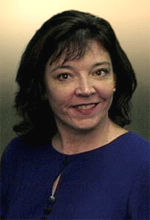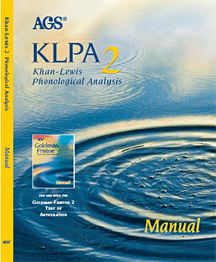Interview with Nancy P. Lewis M.S., CCC-SLP, Co-author of Khan-Lewis Phonological Analysis, Second Edition, (KLPA-2)
Beck:Good morning Nancy. Thanks for joining me today.Lewis:Hello Doug. Glad to speak with you. Beck:Nancy, the KLPA-2 is nothing short of an epic effort culminating in an amazing result. Lewis:Thank you, that's very kind.Beck:You're welcome. However, before we discuss the KLPA-2, would you tell me a
 Beck:Good morning Nancy. Thanks for joining me today.
Beck:Good morning Nancy. Thanks for joining me today.Lewis:Hello Doug. Glad to speak with you.
Beck:Nancy, the KLPA-2 is nothing short of an epic effort culminating in an amazing result.
Lewis:Thank you, that's very kind.
Beck:You're welcome. However, before we discuss the KLPA-2, would you tell me a little about your professional education and background?
Lewis:Sure. I received my bachelor's degree in Speech-language Pathology (SLP) from the University of Florida in 1978 and my master's in 1980 from the University of Arizona. After that, I completed a post-graduate fellowship at the University of Texas Medical Branch in Galveston, and that's where I met Linda Khan. Linda was my CFY Supervisor in a pediatric child-development multidisciplinary team, and we saw a lot of kids with severe speech intelligibility issues. Prior to my arrival, Linda had begun collecting preliminary data to develop a phonological analysis as a companion tool to a traditional articulation test. As she and I collaborated on this idea, we realized it made sense to link traditional phoneme errors and distinctive-feature articulation tests with a phonological approach to comprehensively examine speech sound errors.
Beck:And back then, those approaches were miles apart?
Lewis:Yes, they were very far apart. We realized each offered advantages, and so we wanted to figure out a way to combine the best of both worlds.
 We started working with Goldman and Fristoe and AGS Publishing (American Guidance Service, at the time) to develop a "companion tool" for the Goldman-Fristoe Test of Articulation (GFTA). The GFTA was an excellent tool, very well accepted and had been originally published in 1969. We used their word probes, created standardized data and developed norms down to age 2 years, and the result was the KLPA, originally published in 1986.
We started working with Goldman and Fristoe and AGS Publishing (American Guidance Service, at the time) to develop a "companion tool" for the Goldman-Fristoe Test of Articulation (GFTA). The GFTA was an excellent tool, very well accepted and had been originally published in 1969. We used their word probes, created standardized data and developed norms down to age 2 years, and the result was the KLPA, originally published in 1986.Beck:And then time marched on, and Goldman and Fristoe revised their excellent test...I guess that was in the year 2000?
Lewis:That's right. GFTA-2 came out in 2000. Fortunately, we had the opportunity to examine the data from 2350 individuals as they responded to the 53 stimulus words in the Sounds-In-Words Section of the GFTA-2. Just imagine the possibilities for sound changes! We analyzed every response, identified every phonological process used in the speech sound error, and determined the most relevant phonological processes to score from this data-base. From this vast pool of data, we derived the normative scores, revised the record form, designed a Sound Change Booklet that serves as a tutorial for the examiner, and released a current companion tool for the GFTA-2, of course, called the KLPA-2.
Beck:I cannot even imagine the work, analysis and hours the KLPA-2 must've taken. Nonetheless, the result of that amazing effort is the KLPA-2 is standardized and normed across a vast population and provides an "in-depth analysis of overall phonological process usage." So you actually base the analysis on the "phoneme" level in a comprehensive and repeatable manner?
Lewis:That's right. We use the 53 target words from the GFTA-2, elicited through the Sounds-In-Words Section to provide the single word speech production used for phonological analysis. By transcribing the child's response using IPA and entering the response on the KLPA-2 Record Form, the phonological processes used in the sound changes are identified, and the result can be interpreted with regard to normative data.
Beck:From your perspective, what will the SLP using the KLPA-2 notice as far as changes from the original KLPA?
Lewis:The KLPA-2 record form is actually much more "user friendly" than the original. Another change is that we previously offered severity ratings in the original, and now in the KLPA-2 we offer standard scores.
Beck:Both of those seem like very good steps in the right direction. I know by leafing through the manual that it is incredibly well presented, intuitive, and the normative data is voluminous and highly organized. What about other features of the KLPA-2?
Lewis:The KLPA-2 features include 10 distinct phonological processes that are used when determining a normative score, and the 10 processes are categorized into 3 process areas; Reduction Processes, Place and Manner Processes, and Voicing Processes. These process categories may assist in treatment planning.
Beck:And all of this is normed from ages 2 years to age 21 years, 11 months?
Lewis:Yes. And those age ranges allow us to work in tandem with the GFTA-2 and to be in accordance with the needs of IDEA, both in the past and now into the future. We offer age based standard scores from age 2 years through age 21 years, 11 months.
Beck: Can the KLPA-2 be used to identify specific processes in older folks, too?
Lewis:Yes...we don't offer normative data beyond age 21;11, the KLPA-2 can be used to document and describe articulation and phonological abilities and errors, and can be used over time, too, to track remedial progress as speech and articulation improve over time.
Beck:How long does it take a typical SLP to do a complete KPLA-2 analysis?
Lewis:Well, of course that varies with the client and the SLP, but I think it's reasonable to expect about 15-30 minutes.
Beck:And lastly...who are the best candidates for the KLPA-2?
Lewis:We think that the decision to perform the KLPA-2 is based on the intelligibility of the child's speech. The more unintelligible they are, the more of a candidate they are.
In the manual we stated that if the child is reasonably intelligible and only has a few errors, probably the GFTA-2 is all you'll need. If the child's speech is reasonably intelligible with many error phonemes, that is, lots of misarticulations, the clinician may go with a complete phonological analysis, a distinctive feature analysis, or a standardized articulation test, or any or all of the above. However, when the child is very young, and has moderate-to-severely unintelligible speech, we believe the KLPA-2 should be completed.
Beck:Thanks so much for sharing your time and knowledge Nancy. I am very impressed with the KLPA-2. I congratulate you on the completion of this phenomenal and extremely well done undertaking. Will you be at ASHA this year?
Lewis:Yes. I will be at the AGS Publishing booth (#1101) at various times during ASHA 2005 and will look forward to seeing you there. In fact, if any of the readers or SLPs have questions about the KLPA-2, I would be happy to meet with them at ASHA in the AGS Publishing booth.
Beck:Fantastic. Thanks Nancy.
Lewis:You're welcome. Thank you, Doug
KLPA-2
Khan-Lewis Phonological Analysis, Second Edition
Published by
AGS Publishing
4201 Woodland Road
Circle Pines, Minnesota 55014-1796
1-800-328-2560
www.agsnet.com
(KLPA-2 = Product #1182)
